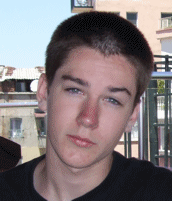

Story By Del Brummet
All This Is That Contributing Music Reporter
Photographs by Claire Brummet
All This Is That Contributing Photographer
The Efes Pilsen One Love Festival was basically a small version of Seattle's Bumbershoot. Tons of hip 18-30 year 0lds were there plus, cool younger kids and older people grasping a hip life style. Keelin, our mom, was the first to become aware of this festival, and she was the one to get me and my sister to go, despite the fact that we thought it would cost 50 Turkish Lira. The bands to play at the festival were Shantel, Miss Platinum, Baba Zula, Kolektif Istanbul, and GOGOL BORDELLO!
 Del relaxing between setsGogol Bordello was of course our first lure
Del relaxing between setsGogol Bordello was of course our first lure, but when we learned that the festival was near at hand and possible to go to we were all in. To start the long and fantastic day, we walked from our apartment to a big square, where we would supposedly get free shuttles to the concert. It turned out perfectly. We stepped onto the bus, and could already tell the day was going to be awesome. After a quick, rocky, and somewhat frightening bus ride to the concert, we stepped out into a part of Istanbul unknown to us, and followed the hipsters onto a college campus.
 Partezani!We bought our ticket at a student price
Partezani!We bought our ticket at a student price of thirty lira which was awesome, and then went through two security checks (separated by gender), and finally came into the festival. It was totally cool looking, with a great lawn and beer stands perched left and right. People walked around and laid in the grass. We had stumbled on an exciting tradition of hip Turkish younguns, and we were stoked. The biggest difference between this festival and Bumbershoot (besides way less people) was that first of all there were waaaaaay more beer stands than food stands (there were four food stands) and also you could drink beer anywhere you wanted. This was a beer festival after all, sponsored by Efes Pilsen, a popular beer in Istanbul.
The first band (we are not actually sure of the name of the band) started and they were awesome, with a far different sound than music we normally hear, with occasional lyrics, and sporting a violin, electric guitar, bass, drums and a trombone. They turned out to be my favorite Turkish band of the night. After that the bands were still interesting, but not entirely notable until a band called Shantel & The Bucovina Club Orkestra appeared.
 The Miller booth, where you could sing high after sucking down heliumShantel & The Bucovina Club Orkestra
The Miller booth, where you could sing high after sucking down heliumShantel & The Bucovina Club Orkestra wasn't notable due to talent, but more the fact that the Turkish people loved them. Their songs included such intelligible and fantastic lyrics as “
Disko! Disko! Partizani!” or another classic “
Parti! Parti! Partizani!” This was from what was obviously the Turks favorite song ,“Disko Partizani.” Figuring out which was the Turkish people’s favorite wasn’t too hard due to the fact that Shantel played it twice! A feat I had never seen in concert and believed only possible in part robot humans….which I would look into for this band. They weren’t incredibly good in the least bit, but people definitely loved them most of all.
Our favorite band Gogol Bordello came on last (eight hours after we arrived). They jumped on stage and started one of their usual raucous songs. The main singer had an awesome guitar that sounded like musical sword in a fight, and other than him there was a drummer, an old violinist man, an electric guitarist, a bassist, an accordionist, and two dancing women in tight pink outfits who were mildly hilarious. Their whole show was awesome. They played a few favorites, along with what sounded like new ones that I hadn’t heard. I have only seen them once before, and the biggest difference about this concert was that no one in the concert moshed, but it still ended up being fantasticalismatatic, as you can see in this maraudingly colorful and wondrous video. We went home on the same free shuttle, and back to the square, in happiness.
---o0o---




































